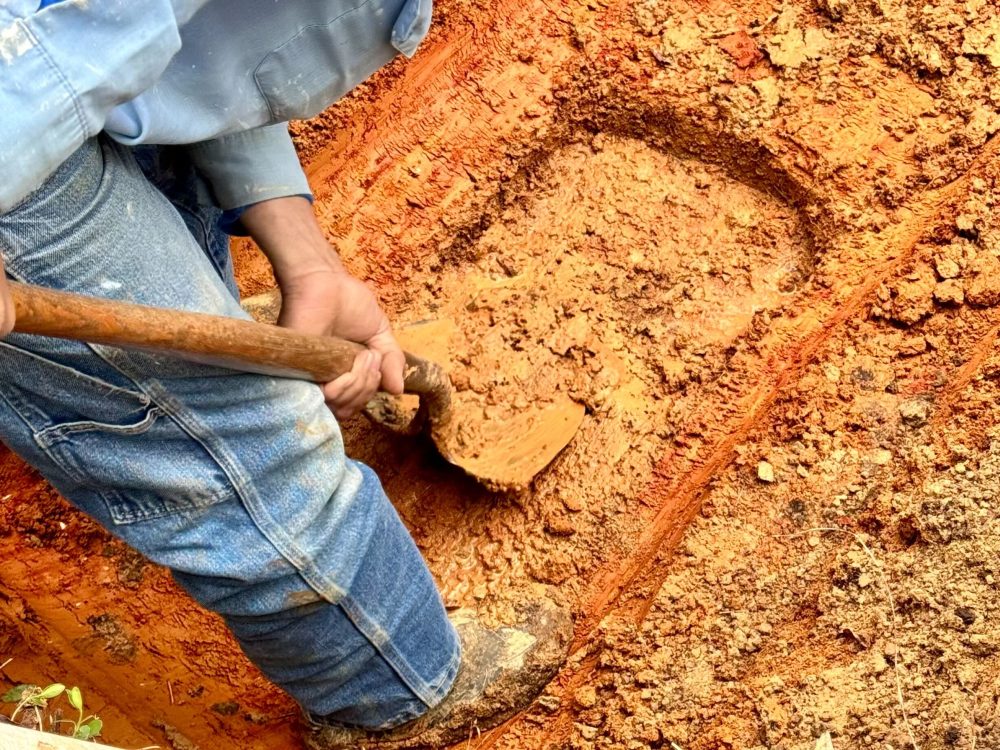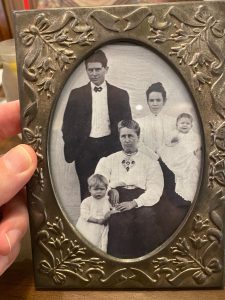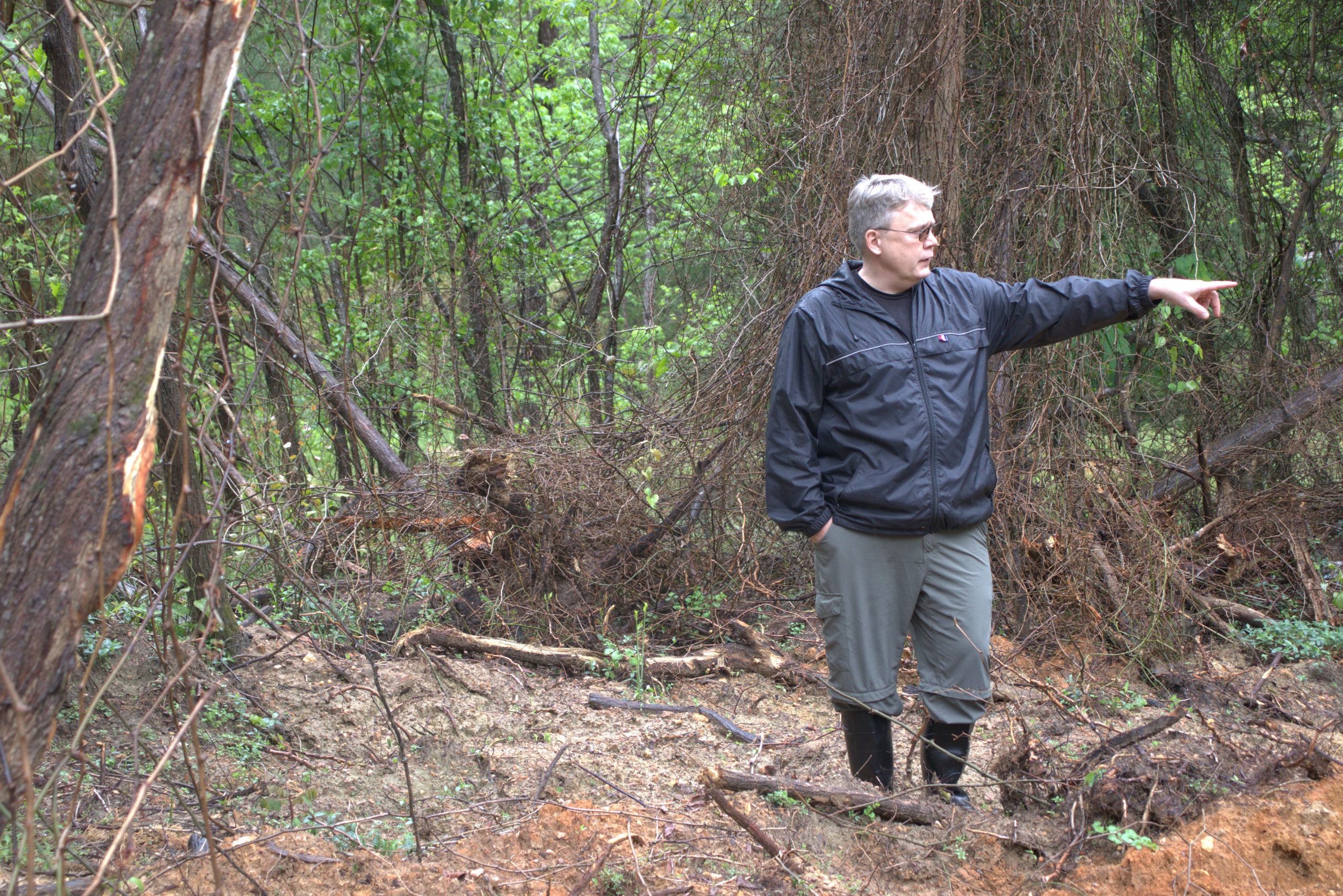On the morning of February 27, John Upchurch arrived at his 58-acre plot at 3104 Carpenter Pond Rd. He inherited the land after his mother died in 2017. For more than 40 years, Upchurch had known about two graves on the property.
By 5 p.m., he would uncover 20 more.
Large cedar trees loomed over the land, a tell-tale sign there was a cemetery nearby. The ground was soft for Steve Ward and his cemetery services team thanks to an unusually wet Durham winter. That morning, Ward’s team reached the land before Upchurch, already probing the earth to begin disinterment. The gravedigger was nicely dressed in a collared button-up. He could’ve been going out to dinner.
For as long as the Upchurch family owned the property, they knew of two marked headstones, belonging to Otis Emory (1916-1925) and Coolidge Emory (1925-1926). Upchurch’s research led him to believe there were three additional graves near the brothers: the graves of their parents, Bernice Franklin (B.F.) and Pearl Emory, and their paternal grandmother, Louella Emory. Although, he couldn’t say for sure.
The entire process began because of the two Coolidge boys. As Upchurch nears retirement, he plans to sell the land. The property is worth more than $1 million according to Durham County Property Tax Records. At least once a month, developers reach out to him looking to buy.
“I sort of thought of them as orphaned,” said Upchurch. “I didn’t want to leave it up to somebody else… you know, I’d been living with them for 40 years and felt responsible.”
Upchurch tracked down the family’s next of kin — B.F. and Pearl Emory’s 13 living grandchildren — through certificates of death and genealogical research. (He’s charted an impressive family tree on Ancestry.com.) Upchurch wanted their blessing to relocate the graves, understanding that he would be expected to pay all expenses related to disinterment and reinterment.
Each family member who responded to Upchurch supported moving the graves to Woodlawn Memorial Park in Durham where their uncles and aunts are resting. So, in compliance with county regulations, Upchurch went to the Durham Board of County Commissioners who approved the request in December.
Then in February, the disinterment process began around 8 a.m. Ward had been in the business long enough to come prepared with extra boxes.

Development collides with the past
In a 2023-2024 report from the U.S. News & World Report, the Raleigh/Durham area ranked among the top 25 fastest-growing cities in the country. In many ways, this means growth for the community — more jobs, better technology, improved quality of life. However, a changing skyline forces development to intersect with grave discovery. Our past butts up against progress, raising questions about how to balance historic preservation with innovation.
Most of Ward’s “projects are through corporations that are… building an apartment complex or a neighborhood or something like that,” he says.
Under federal law, a grave is considered “historic” if it is more than 50 years old (36 CFR §60.4). The North Carolina Office of State Archaeology has a historic cemetery program dedicated to locating old graves and assisting descendents, landowners, and researchers with information.
Historic Cemetery Specialist Melissa Timo says cases like Upchurch’s are becoming increasingly common. Her position was created for the sole purpose of answering calls like: “I bought a piece of property, and there are dead people in the backyard, what the heck do I do?!” There’s a website devoted to FAQs. Including: “Someone else now owns the land where my ancestors are buried. What can I do?” and “I have an old abandoned cemetery on my property. Do I have to maintain the cemetery or let family members come on my land?”
“There’s 12,000 years of human history in the state, so there are lots of cemeteries to pop up,” says Timo, “And especially as we develop more and more of it, these places that were protected by nature of camouflage, aren’t being hidden anymore.”
Ideally, if a landowner found a grave on his property, the first thing he should do is reach out to the state archaeological department and register the cemetery, she says. It’s important from a historical standpoint to get a better idea of how the land was used. Also, in case relatives of the deceased reach out, Timo can help direct them by locating their ancestors.
Upchurch never consulted historical or archaeological resources. It didn’t occur to him to do so, he says. He knew the Emory brothers’ names from the tombstones, and Ancestry.com made it easy to trace their parents. “I didn’t feel like I needed any additional information,” says Upchurch.
A row of “unknowns”
It’s drizzling on the Sunday afternoon when I meet the landowner. We’re trekking through mud — mud where bodies used to be — while he describes the disinterment in February.
Upchurch got to his property at 9:15 a.m. to find Ward already digging further in the forest. He redirected them to the cemetery. “Oh yeah, oh yeah– we’re gonna find them here,” said a member of Ward’s team, brandishing a metal probe.
Patrick Eaton, with the Durham County Department of Public Health, and a funeral director were also on the property, overseeing the project.
Upchurch’s suspicions were correct. Otis and Coolidge’s parents and grandmother were buried together. It only took a couple hours to disinter the Emory family. But, Ward said it was his job to find any and all graves on the land. He warned he might find more.
“My understanding is Steve always finds extras,” Upchurch later tells me. Sure enough, after digging towards the end of the Emory row, Ward discovered the first “unknown.”
The landowner was confused at first. He had done his homework — there were only supposed to be five graves.
The gravedigger continued down the row. His tractor uses a straight blade, rather than teeth, to remove the topsoil by one half-inch at a time. Once he arrives at a clay layer, if it’s not solid red, a faint rectangular outline of a coffin can be seen. A second unknown.
Then, a third. And a fourth.
With each uncovered unknown, Upchurch wished it was the last. Every time Ward’s team discovered a new grave, it meant another $1,000 the landowner would be expected to pay. Under NC General Statute 65-106, “all expenses of disinterment, removal, and acquisition of the new burial site and reinterment shall be borne by the party effecting such disinterment, removal, and reinterment.”
“You would think that it would all be very solemn, right? It’s respectful, but there is an element of, like, fishing to it,” says Upchurch. It started to feel like a game to him, landowner against gravedigger. Upchurch: 0, Ward: 9.
Ward even gave Upchurch a discount because he felt bad. “Today, it’s kinda hard to find people that want to do the right thing all the time,” says Ward about the landowner. He’s been digging graves since the 1990s.

Based on the shape and condition of the unknowns, Ward estimated the graves were around 100 years older than the Emorys’. Traditional coffins, popular up until the American Civil War, are wider at the shoulders and taper off by the feet.
Identifying the nameless graves would be tricky. Durham County was founded in 1881, and it wasn’t until 1913 that North Carolina issued certificates of death.
Upchurch was at peace with his decision to relocate the five Emorys — to unite B.F. and Pearl Emory with seven of their children. In Upchurch’s letter to the county commissioners, he wrote his plans to “preserve their connection to the Upchurch Property by constructing a small memorial garden and dedicating a permanent marker in memory of the Emory family.” Also, someone had vandalized Otis and Coolidge’s marked headstones with a shotgun, so Woodlawn would provide better care.
But, Upchurch wasn’t anticipating the unknowns.
“Looking back on it, I probably had the legal right to say, “No — this is all I’ve got permission for. So… stop,” Upchurch later says to me.
Ward kept digging. After all, he expected to find more. “I always carry 20-25 boxes,” says Ward, “I’ve been doing this too many times.” The extras kept filling up. Upchurch grew more and more anxious.
By then, it was lunchtime. Upchurch went to Chick-fil-A to bring back food for the crew.
A place for preservation?
“From a preservation standpoint, we always first advocate for just leaving things as they are,” says Julianne Patterson. She’s the executive director of Preservation Durham, a private nonprofit organization committed to protecting Durham’s history through education, advocacy, and action. But, she recognizes how complicated the situation can be. Landowners don’t have any obligation to maintain cemeteries on their property, and they are within their legal rights to relocate the remains.
The organization works with the state archaeology department to proactively locate abandoned cemeteries. It’s difficult to protect these places without identifying them first.
This isn’t easy, especially when it comes to African American graves. Black cemeteries tended to be marked, at best, with field stones or wooden markers that disintegrated over time. It wasn’t until the turn of the century, after Emancipation, that we see more standardized, commercially-made markers, says Timo. Otherwise, daffodils, periwinkle, and yucca are common plantings around gravesites.

But, because of resources like Ancestry.com and political movements like Black Lives Matter, there’s been greater interest in abandoned African American cemeteries.
“I would say 10 years ago, cemeteries were hardly even on the radar of historic preservationists,” says Patterson. “In the last 10 years, there’s been more of this recognition… that segregation existed in burials, too, and that we need to be doing a better job as a nation in identifying these historically African American cemeteries.”
The Emory family is white, but what about the unknowns? “Could they have been slaves? They could have,” says Upchurch, “I thought about it. I don’t know.”. B.F. Emory bought the land in 1919, so the unknowns are likely unrelated to them.
Without a deeper understanding of the land’s history, all that anyone can do is speculate about the nameless graves’ identities. The cemetery could have belonged to a lower-class white family. It could’ve been a white family buried with their Black slaves. Or, an abandoned slave cemetery.
The entire cemetery was covered with periwinkle, located on a high point of the land near the Emory family cemetery. Periwinkle is a “very strong” indicator of a potential burial ground for enslaved people. But, the flower is also a common groundcover, “so it could also have been planted somewhere and just sort of run wild,” says Timo.
And so, the unknowns remain just that: unknown. Upchurch can’t make any determinations about their identities.
Despite a growing interest in cemeteries, there’s no guarantee that landowners will know who to contact if they find an abandoned gravesite. When Upchurch reached out about relocating the remains of two Emorys, he started with Tania De Los Santos, an administrative assistant in the Durham County Clerk’s office. The county administrator directed him to Eaton, who assisted in preparing a request to the commissioners.
“Once I contacted Durham, Patrick basically told me what I needed to do, and that didn’t involve the state,” says Upchurch.
Timo’s position wasn’t formally established until 2019. Despite a high demand for helpful resources when it comes to historical cemeteries, “it’s only been me for the last five years,” she says.
“It is really hard to get into all of our communities,” Timo continues. “We’re seeing not only a gap of knowledge for the landowners, we see a big gap for local governments, and we see a big gap with law enforcement.” What’s on the surface very rarely matches what’s underground.
It wasn’t until Feb. 27 that Upchurch learned his land held centuries of history.
Grave realities
After lunch, the team returned to where they found four unknown graves, confirming those were the only ones in the second row. But more probing indicated a third row.
“My heart started to sink a little bit,” Upchurch remembers. “It starts becoming a numbers game… dollars, cents.”
Another unknown grave. (…plus $1,000)
And another. (…plus $1,000)
And another… until 13 total graves were discovered in the third row — many of them infants. The burial spaces weren’t much bigger than shoeboxes. At around 5 p.m., Ward needed to head out to visit his mother in the hospital. The 17th unknown grave marked the end of the third row and the end of the first day.
Ward’s team returned the next morning to search for a fourth row. They didn’t find anything, keeping the grand total of graves at 22 with 17 unidentified.
At rest(less)
The Emory remains have been relocated to Woodlawn, as planned. In March, Upchurch once again requested approval from the Durham Board of County Commissioners to relocate the 17 unknown graves to Markham Family Cemetery, per Ward’s suggestion. The board approved his request in its April 8 meeting.

On April 24, the 17 unknown remains were reinterred into four cemetery plots. Before that, they remained in the gravedigger’s custody, under the supervision of a funeral director. Upchurch and his wife took out a $25,000 loan from their retirement savings to pay for their disinterment and reinterment. In addition to paying $1,000 for each removal, Upchurch spent $8,000 on the Markham burial plots.
A public record is being filed with the Durham Register of Deeds that may one day help the nameless graves be identified. “The unknown remains are more than an unexpected expense,” Upchurch texted me. “The unknown remains represent real lives… I want to do better for them when I can.”
At the Upchurch property now, all that’s left from unearthing more than 200 years of history is a lot of mud. And clumps of periwinkle. It’s hard to put a price on heritage.
Above: John Upchurch points out the site where old graves were discovered on his property. Photo by Maddie Wray — The 9th Street Journal





